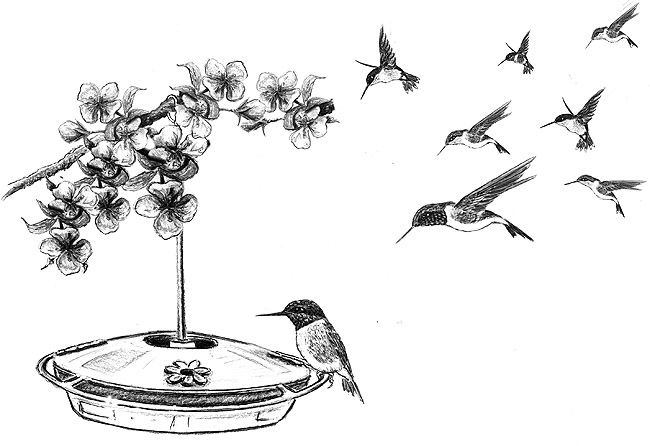
Dear Bird Folks,
Is it too late to put out a hummingbird feeder? I was thinking about buying one but my neighbor told me that putting out a feeder this time of year would prevent the hummingbirds from migrating. Is he right? What do you think?
– Sally, Dennis. MA
This is a tough one, Sally,
It’s unlike me to advise someone not to buy a bird feeder. That would be like a clerk in an electronics store not trying to sell you one of those overpriced extended warranties. But in this case, I don’t think you need to run out and buy a hummingbird feeder, although my reasons have nothing to do with migration (more on that in a minute). The hummingbird season is starting to wind down and the majority of the hummingbirds have already left the Cape. If you purchase a feeder now you won’t really need it until next April, and by then you might not remember where you put it. Then you’ll have to go out a buy another one and… Wait! Let me rethink this. If you buy a feeder now and misplace it over the winter, you’ll have to buy another one. Forget what I said earlier. Buy your feeder now and I’ll see you again next spring.
You can feed hummingbirds anytime. I don’t know where these foolish rumors come from (maybe your neighbor), but this year I’ve had more questions about feeding hummingbirds in the fall than ever before. Just after I received your call, another lady, Nancy, also from Dennis (perhaps you know her), called me with the same question. Putting out a hummingbird feeder in September won’t keep hummingbirds from migrating anymore than speed limit signs keep Boston drivers from driving wicked fast. It’s not a factor.
Bird migration is a complicated event. Some migrations, like last year’s crossbill invasion, are clearly triggered by a shortage of food. But other migrations have nothing to do with lack of food. In fact, birds often leave an area when food is most abundant. They know that things will soon be changing. Based on instinct, and what they’ve read in the Old Farmer’s Almanac, birds understand they need to get out while the gettin’ is good.
What is interesting about hummingbird migration is that most folks don’t even realize it’s going on. We see flocks of geese flying overhead, shorebirds gathering on the beach and waves of hungry grackles as they eat their way through our backyards, but hummingbirds don’t travel in flocks and are far less obvious. Yet, right now millions of them are quietly streaming south via our neighborhoods. This brings up an unsettling fact. Many folks are under the impression that they see the same hummingbirds everyday. Some people even have names for them. “Sippy” they say “greets us every morning.” But the fact is, from about mid-July on there is a constant stream of birds coming to our yards. The hummingbirds we see feeding from our feeders today will be long gone by tomorrow, only to be replaced by their very similar-looking cousins. Customers always bristle when I tell them that “Sippy,” their favorite hummingbird, is actually a one-night stand, but then again, most people bristle anytime I say anything.
Hummingbird migration takes place over several months. Males are the first to go. Since they have nothing to do with nest building or raising the kids, they get out of town early. By the end of July thousands of male hummers are working their way south, stopping at our feeders and flowers as they go. (This is where your neighbor’s theory starts to fall apart. If feeders prevented the birds from migrating, why do the males leave in July, when food is most plentiful? I’m just saying.) The females head out next, followed by the young birds. Peak migration runs from August to about the middle of September. A bird bander recently told me that he set up a trap around a nearby feeder to catch and band hummingbirds as they stopped to eat. On a single day last week he caught and banded fifty-six different hummingbirds as they came to eat in one yard, on one feeder. To the birds, our feeders are just tiny drive-thru restaurants, without all the litter.
It seems every year we hear a story about a lost hummingbird that is still coming to a feeder in late December. People like your neighbor might point to this story and say, “See, because a feeder wasn’t taken down in the fall this poor bird didn’t migrate.” The fact is the feeder isn’t the problem; it’s the bird. The bird clearly has some directional or physical issues. The feeder didn’t keep it from heading south, but the feeder will keep it alive… at least for a little while. People naturally get attached to these lost birds and may take extraordinary steps to keep them alive. But the cruel truth is, it’s probably better for all of the hummingbirds if these defective birds simply come out of the gene pool. (See, I told you people bristle when I say anything.)
Don’t listen to your neighbor, Sally (and Nancy). You can put out a hummingbird feeder anytime you’d like. It won’t hurt to try to attract hummers before September comes to an end, but you’ll probably have better luck if you wait until next spring. Most importantly, however, don’t be afraid buy a feeder now, and then again in the spring, and several more in between. That’s what really matters.